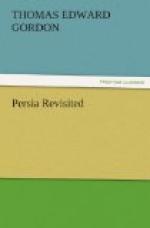CHAPTER II
—The late Shah’s long reign —His camp life —Habits —Appearance —Persian Telegraph Intelligence Department —Farming the revenues —Condition of the people —The shoe question —The customs —Importation of arms —Martini-Henry rifles —Indo-European telegraph
Nasr-ed-din Shah was the two hundred and fifty-fourth Sovereign who had successively ascended the throne of Persia. He succeeded his father, Mahomed Shah, on September 10, 1848, and would have entered on his jubilee, the fiftieth year of his reign, according to the Mohammedan calendar, on May 6, 1896, had not his life been suddenly cut short by a dastardly assassin on Friday, May 1. This was, I think, the longest reign of any Persian monarch that can be ascertained with historical accuracy, except that of Shah Tamasp, who died A.D. 1576, after occupying the throne for fifty-three years; but this credits him with having begun his reign at the age of ten years. Nasr-ed-Din Shah ascended the throne at the age of seventeen. Up to the last his Majesty was remarkable as retaining all his physical and mental energies; his health was excellent, due no doubt to his love of nomadic life and its simple habits. He was passionately fond of the chase, and passed much of his time in the saddle. It might well be said of him, as of the ancient Persian monarchs, that the royal edicts were written ’at the stirrup of the King,’ for his Ministers had to follow him into the camp and the hunting-field, and this prevented his Court becoming lapped in luxury. Large tracts were preserved for him for ibex and moufflon on the mountains, and antelope on the plains, and the hawking of duck or partridge on by-days. This nomadic life, with its hunting habits, encouraged the pleasant, easy manner which attracted his subjects and commanded their confidence. He was an energetic worker, and had full knowledge of all home and foreign affairs. He was superior to all palace intrigues, if any existed, and his Ministers were rarely changed. The long continuance in office of his councillors added to the feeling of public security which his own strong personality had given to the country.
In appearance Nasr-ed-Din Shah was little changed since 1889, when his figure was a well-known one in Europe. He showed the same alertness of step, brightness of look and manner, and smartness of dress, which distinguished him then. In his Court he was a striking figure, in marked contrast to those about him, for it must be confessed that all in attendance showed some neglect of appearance which compared unfavourably with the tout ensemble of their Sovereign. This may possibly have been a subtle form of flattery, so that the Shah alone might catch the eye and be the ’observed of all observers’—’le Roi-Soleil’—of the land of the Lion and the Sun.




